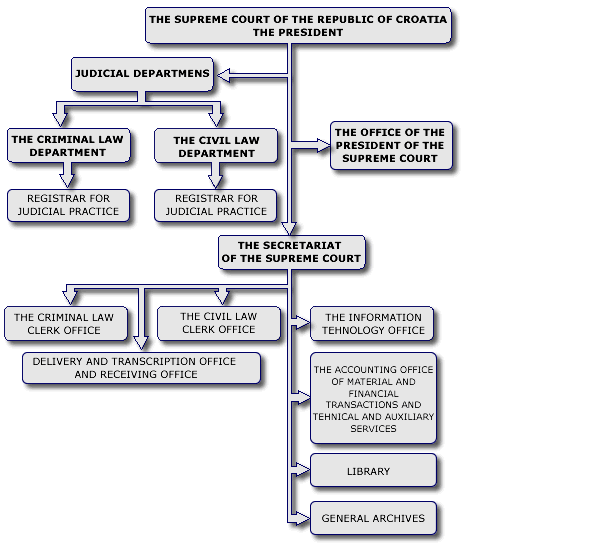The internal organization of the Supreme Court of the Republic of Croatia is regulated by the Law on Courts (Zakon o sudovima; published in "Narodne Novine", no. 150/05) and by the Rules of Procedure of the Supreme Court of the Republic of Croatia, no. Su-235-IV/1999 of 20 April 1999, issued by the President of the Supreme Court following an opinion issued by the General Convention of the Supreme Court.

The Role of the President of the Supreme Court of the Republic of Croatia
The President of the Supreme Court of the Republic of Croatia, in accordance with art. 30 of the Law on Courts (Zakon o sudovima; "Narodne Novine", no. 150/05), represents the Supreme Court of the Republic of Croatia, and performs the tasks of court administration as well as other tasks regulated by law and the Rules of Procedure of the Supreme Court (Poslovnik o radu Vrhovnog suda Republike Hrvatske). These tasks include: administering the work of the Supreme Court; organizing the internal workings of the Court; coordinating the work of the judicial departments and other organizational units of the Court; performing tasks in connection with the status of the justices and other employees of the Court; performing tasks in connection with judicial appointments, judicial removals and the professional development of judges and other employees of the Court; statistics; supervising the financial operations of the Court; supervising the timely and orderly performance of all work within the Court; and cooperating with the supreme courts of other states and with international organizations for promotion of the rule of law.
The Office of the President of the Court
The Office of the President of the Court is represented by the Head of the Office.
The Office is responsible for all protocol tasks connected with official visits to the President of the Court or the justices, the issuing of public statements and carrying out translation duties.
The Office organizes the President's obligations and keeps a record of his/her duties, meetings and appointments.
The Office keeps all ledgers, logs and registers pertaining to the court administration.
The Secretariat
The Secretariat is headed by the Secretary General of the Supreme Court.
The Secretariat assists the President of the Court in carrying out the administration of the court. It drafts the normative acts of the Court, issues opinions and suggestions on acts discussed by the Supreme Court, proceeds upon citizens' complaints and deals with human rights issues, deals with issues connected with the labour relations of the justices and other employees of the Court, drafts decisions connected with the court administration for the General Session of the Supreme Court, and maintains statistical data for all courts.
The Secretariat oversees and coordinates the work of organizational units assigned various administrative tasks. These include filing, the opening and copying of case files, the delivery and storage of files in temporary and general archives; budgeting and accounting, computerization of the court and the maintenance of databases, administering the court library, and other technical and auxiliary tasks.
1. Subdivision of Clerk's offices of the Court
A. Clerk's Office of the Civil Law Department
B. Clerk's Office of the Criminal Law Department
C. Office for transcription and delivery
D. Office for receiving mail and visitors (Intake Office)
2. Subdivision for finances, accounting and supplies, general tasks and technical maintenance
A. Finances, accounting and supplies
B. Technical Maintenance
3. Division for Information Technology
4. Library
5. General Archives
1. Subdivision of the Clerk's offices
This subdivision is charged with the following judicial administrative tasks within the Court: receiving case files, opening and sorting case files, maintaining ledgers and auxiliary books, delivery of case files to assigned panels for deliberation, docketing, maintenance of statistics, transcription, delivery and mailing, temporary archiving and informing parties of the status of their cases.
The subdivision is supervised by the Subdivision Manager - a senior secretary within the Office of the President of the Supreme Court.
2. Subdivision for finances, accounting and supplies, general tasks and technical maintenance
This Subdivision has two departments, each of which is run by a department manager.
The department for finances, accounting and supplies oversees the expenses of the Supreme Court, drafts financial plans and reports, calculates salaries and compensations, and procures goods and services.
The department for general tasks and technical maintenance is responsible for the transportation of the officials and employees of the Supreme Court, delivery of court correspondence, maintenance of the court building, safety at work, maintenance of the telephone system, security, cleaning and catering at the court canteen.
3. Division for information technology
This Division is developing a general program, and conducts particular projects related to the computerization of the Supreme Court, such as the development of LAN, intranet and the management of the Supreme Court’s website, preparation and exchange of documents in electronic format, design of necessary software, maintenance of databases, carrying out computer training for employees of the Court, and assisting in the development of information technology in other bodies of the judiciary.
The division is run by a divisional manager.
4. The library
The library of the Supreme Court is a specialized, limited-access library that performs the following tasks: the maintenance of the collection; the purchasing, sorting and cataloguing of new publications; the lending of materials from the collection; and the maintenance of the appropriate records.
The library is run by the library manager.
5. The General Archive
All case files, documents, office and business books and registers of the Court, as public and historical material, are kept in the General Archive of the Supreme Court. The General Archive maintains records of the stored material, selects the material that must be passed on to the State Archives, selects the court decisions to be published, and grants access to the stored materials.